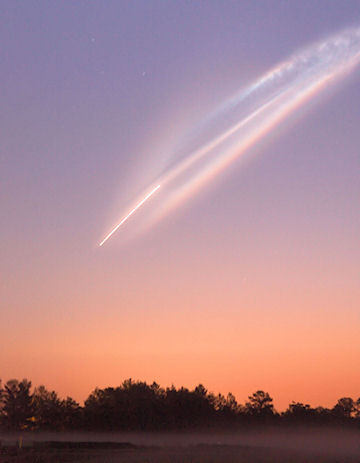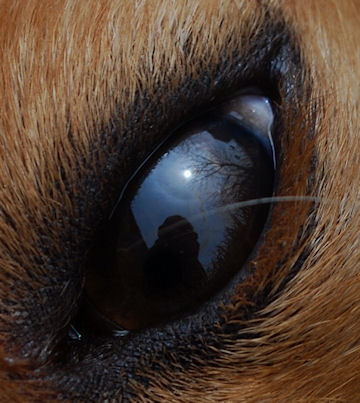NEW AND IMPROVED: Turn your iPhone or iPod Touch into a field-tested global satellite tracker. The Satellite Flybys app now works in all countries. | | | GEOMAGNETIC STORM: A sharp gust of solar wind hit Earth's magnetosphere today, April 5th, at approximately 0800 UT and sparked the strongest geomagnetic storm of the year (Kindex=7). Although the storm is subsiding now, it is not over. High-latitude sky watchers should remain alert for auroras. [gallery]. AMAZING LIFTOFF: Space shuttle Discovery left Earth this morning at 6:21 am EDT in a spectacular dawn launch from Cape Canaveral. The combination of sunrise colors and the comet-like appearance of the departing shuttle astonished onlookers. "It was an awesome sight," says Michael Fertic, who sends this picture from Spring Hill, Florida: 
The show continued even after the shuttle was out of sight. Tiny ice crystals in Discovery's lingering exhaust caught the rays of the rising sun and formed an artificial noctilucent cloud of startling brightness. Even veteran observers were impressed. "It was the most incredible launch I have ever seen," says long-time shuttle watcher and part-time NASA medic Dr. Mark Staples of Shands Hospital. "Definitely, it was one of the most spectacular!" agreed Jim Burchfield of nearby St. Cloud, Florida. And Terry Allshouse of Leesburg, Florida, ranked it as "the best of the ten I have witnessed." More superlatives may be found among the links below. more images: from Mark Staples of Waldo, Florida; from George Fleenor of Bradenton, FL; from Anna Herbst on the NASA Causeway, Titusville, FL; from Terry Allshouse of Leesburg, Florida; from Jim Burchfield of Saint Cloud, Florida; from Adam Bojanowski of Oviedo, Florida; from Jeremy Judkins of Clearwater, Florida IN THE EYE OF THE BEHOLDER: Do dogs appreciate the sky? Tony Phillips, author of spaceweather.com and a longtime dogsledder with twenty Siberian huskies in his backyard, believes the answer could be "yes." Many times he's heard the songs huskies sing at the Moon and caught pairs of blue eyes fixed on a particularly starry sky. It always seems to be more than a blank stare. With these points in mind, consider the following: 
Károly Vicián took the picture on April 4th in Heréd, Hungary. "We had a lot of high cirrus around noontime," he says. "When sunlight hit those icy clouds, a vivid 22o halo appeared in the sky. Later I sighted it in my dog's eye when we were playing, and I bent over for a quick shot with my Nikon D80." Is it just a reflection, or is there beauty in the eye of the beholder? Readers must decide for themselves; Vicián's dog refuses to say. more images: from Roberta Welton of Monarch, Utah; from Tibor Hollósy of Budapest, Hungary; from Gilles Boutin of Parc des Pingualuit Nunavik;
UPDATED: April Northern Lights Gallery
[previous Aprils: 2009, 2008, 2007, 2006, 2005, 2004, 2003, 2002] | 
